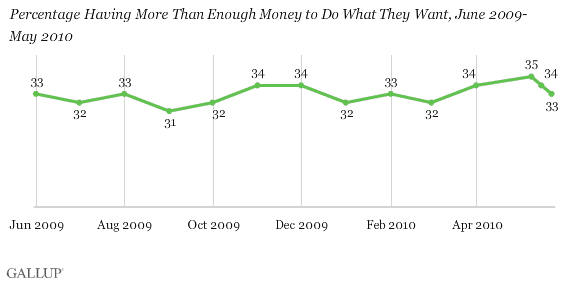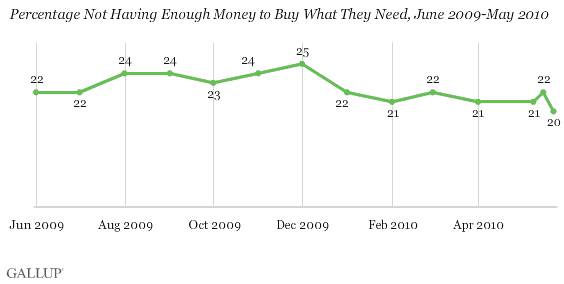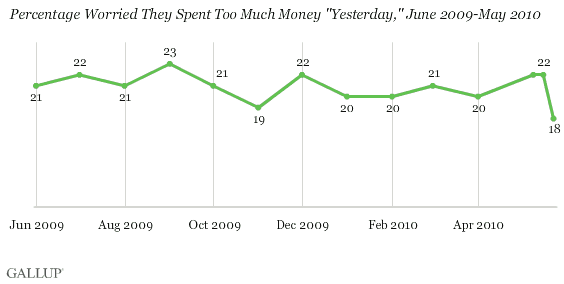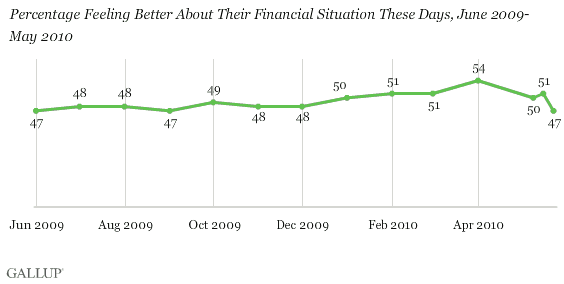PRINCETON, NJ -- Gallup's Standard of Living Index -- a key measure of financial well-being -- reached its highest point in more than two years in April, and has maintained that level during the first three weeks of May. This improvement is driven by a steady increase in the percentage of Americans saying their standard of living is "getting better" -- 47% during the week ending May 23.

One in Three Have More Than Enough Money to Do What They Want
Having "more than enough money to do what you want to do" -- another key measure of financial well-being -- also increased, to 34% in April -- matching the highest level for this measure since November and December 2009. Although it shows nominal declines in the first three weeks of May, this percentage hasn't changed significantly during that time.

One in Five Don't Have Enough Money to Buy What They Need
Fewer Americans (21%) in April said they did not have "enough money to buy the things [they] need" -- matching the lowest level for this measure, recorded in February. This percentage also shows nominal change, but essentially held, during the first three weeks of May.

Fewer Americans Are Worried They Spent Too Much
Adding to the positive news, the percentage of Americans saying they worried that they spent too much money "yesterday" fell to 18% during the week ending May 23 -- down from 22% each of the previous two weeks and lower than any monthly measurement since July, when Gallup began asking this question daily.

Percentage Feeling Better About Their Financial Situations Up, Then Down
Finally, the percentage of Americans "feeling better about [their] financial situation" hit 54% in April, its highest since measurement began. However, this percentage has declined steadily in May, with 47% feeling better during the week ending May 23.

Global Financial News in May Takes a Toll
Several measures of Americans' financial well-being improved during April and seem to be holding their gains in May. Americans feel their standard of living has improved, and more say they are able to buy what they want, while fewer say they are unable to buy what they need. At the same time, their worries about money were unchanged and their feelings about their financial situations got better last month. As a result, all signs seemed to suggest that Americans' financial well-being was improving in April.
However, the key question going forward is whether the positive financial well-being momentum of April can be maintained in the face of a financial crisis in the European Union, a plummeting euro, and a plunging stock market. One sign of the possible negative impact of these events may be reflected in the way fewer Americans in May are feeling better about their financial situations than were feeling this way in April. Further confirmation may follow if the nominal declines in most of the other measures of financial well-being soon become significant. Regardless, caution is warranted, as is careful monitoring of Americans' well-being in the weeks ahead. A plunge in financial well-being would not be good for the overall U.S. economy or political incumbents as the midterm elections approach.
Review and export the complete daily trends on these measures: Economic Indexes; Consumer Spending; Economic Outlook; Economic Conditions; Job Market; U.S. Workforce
Learn more about Gallup's economic measures.
For Gallup Daily tracking, Gallup interviews approximately 1,000 national adults, aged 18 and older, each day. The Gallup consumer spending results are based on random half-samples of approximately 500 national adults, aged 18 and older, each day. Results for the week of May 23 are based on telephone interviews with more than 700 adults. For these results, one can say with 95% confidence that the maximum margin of sampling error is ±4 percentage point. Results for the various breakouts reported here are based on interviews with more than 1,000 respondents, with a maximum margin of error of ±3 percentage points.
Interviews are conducted with respondents on landline telephones (for respondents with a landline telephone) and cellular phones (for respondents who are cell phone only).
In addition to sampling error, question wording and practical difficulties in conducting surveys can introduce error or bias into the findings of public opinion polls.
